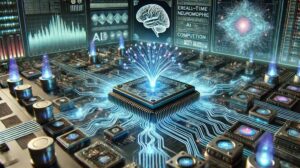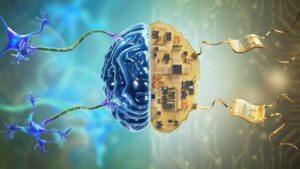
As we approach the physical and energy limitations of traditional computing architectures, the search for new paradigms that can support the next wave of artificial intelligence (AI), robotics, and real-time processing is intensifying. At the forefront of this technological evolution are two groundbreaking approaches: neuromorphic computing and hybrid computing.
These innovations draw inspiration from both the biological brain and the convergence of classical and non-classical systems, promising breakthroughs in efficiency, adaptability, and intelligence.
What Is Neuromorphic Computing?

Neuromorphic computing is a paradigm that mimics the neural structure and processing mechanisms of the human brain. Instead of relying on conventional von Neumann architecture, neuromorphic systems use spiking neural networks (SNNs) and specialized hardware—such as memristors and neurosynaptic chips—to process information more like a biological brain.
Key Characteristics:
Event-driven processing (asynchronous)
Energy-efficient computation
Massively parallel architecture
Real-time learning and adaptation
Developed initially by researchers at IBM, Intel, and various academic institutions, neuromorphic hardware like IBM’s TrueNorth and Intel’s Loihi have demonstrated impressive power savings and latency advantages in tasks such as pattern recognition, sensor integration, and robotic control.
The Promise of Hybrid Computing
Hybrid computing combines multiple computational models—often blending traditional CPU/GPU architectures with neuromorphic, quantum, or analog components. The goal is to leverage the strengths of each approach for optimal performance, power efficiency, and flexibility.
Examples of Hybrid Systems:
CPU + Neuromorphic accelerators for low-latency inference
GPU + Quantum processors for solving combinatorial optimization problems
Digital + Analog co-processing for real-time sensory integration
Hybrid computing reflects a broader trend in architecture: specialization over generalization. By orchestrating different processors for different tasks, systems become more scalable, context-aware, and resource-efficient.
Applications and Real-World Impact
1. Edge AI and Robotics
Neuromorphic chips excel in low-power, real-time inference, making them ideal for autonomous systems such as drones, wearables, and smart cameras. Unlike conventional AI chips, they don’t require cloud connectivity or large datasets to function effectively.
Example: Intel’s Loihi has been tested in adaptive robot navigation, reducing energy use by over 90% compared to standard processors.
2. Brain-Machine Interfaces (BMIs)
Neuromorphic hardware is being explored for brain-inspired interfaces that interpret neural signals in real time, opening possibilities in prosthetics, neuroscience, and neural rehabilitation.
3. Sensory Processing in IoT
Hybrid architectures can fuse data from multiple sensors—visual, auditory, tactile—in a more human-like manner. This is crucial for ambient intelligence, smart homes, and next-gen human-computer interaction.
4. Scientific Research and Simulation
Complex models such as climate simulations, drug discovery, or nuclear fusion require enormous processing power. Hybrid systems can allocate tasks efficiently: CPUs for control logic, GPUs for matrix operations, and neuromorphic/quantum components for optimization.
Advantages of Neuromorphic and Hybrid Approaches
Feature Traditional Computing Neuromorphic/Hybrid Computing
Energy Efficiency Moderate to High Extremely Low (esp. in neuromorphic)
Parallelism Limited (multicore) Massively parallel
Adaptability Software-based Hardware-encoded & dynamic
Real-Time Inference Cloud-reliant On-device, low-latency
Scalability for Edge Devices Limited High
Challenges Ahead
Despite their promise, these technologies face significant hurdles:
Tooling and software support: Programming for neuromorphic and hybrid systems requires new languages, compilers, and frameworks.
Standardization: There is no unified architecture or API layer yet, slowing adoption.
Hardware scalability: Neuromorphic chips are still in early-stage development compared to mature CPU/GPU ecosystems.
Cost and complexity: Hybrid systems can be costly and complicated to integrate and maintain
However, ongoing investment by governments, academia, and tech giants is rapidly accelerating the maturity of this space.
The Road Ahead
The future of intelligent computing will not rely on a single architecture, but rather a diverse ecosystem of specialized processors working in concert. Neuromorphic and hybrid computing represent a necessary shift to meet the demands of:
Real-time AI at the edge
Ultra-low-power mobile computing
Scalable robotics and automation
Brain-inspired, context-aware systems
As Moore’s Law slows, the innovation curve shifts toward architecture and efficiency, not just raw processing power. Tech leaders who invest early in neuromorphic and hybrid systems will be best positioned to lead in AI, robotics, and next-generation computing platforms.
Conclusion: A New Era of Smart Machines
Neuromorphic and hybrid computing are not just incremental improvements—they represent a paradigm shift. By drawing lessons from the human brain and blending different processing models, we are moving closer to machines that can learn, adapt, and think with unprecedented efficiency.
In this new era, intelligence is no longer bound by binary logic or linear pathways—it is becoming organic, distributed, and deeply integrated with the world around us.
